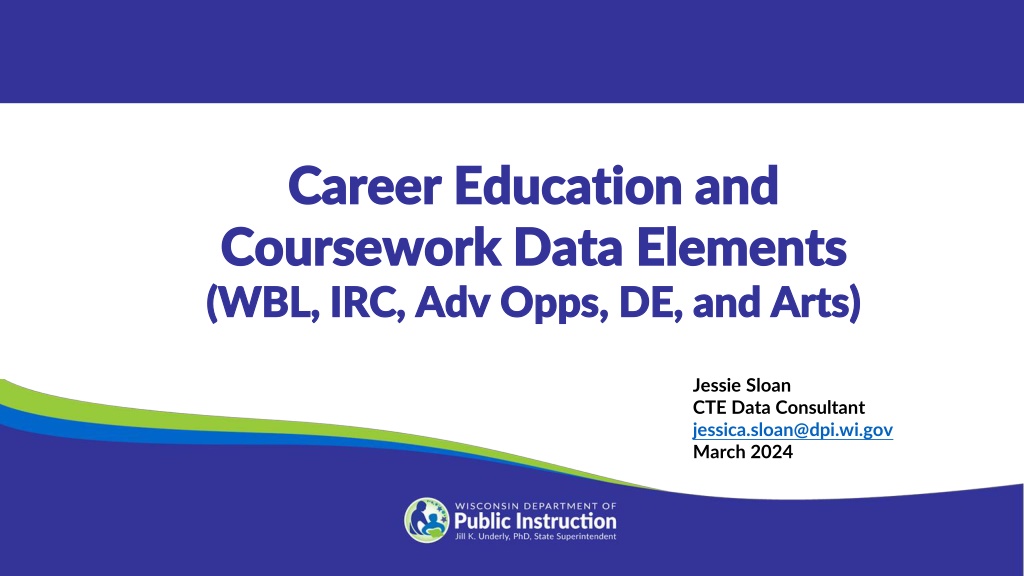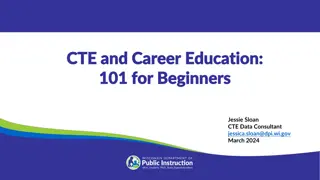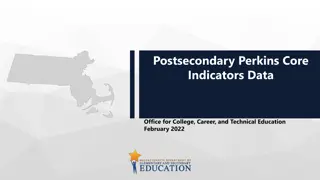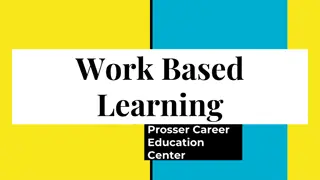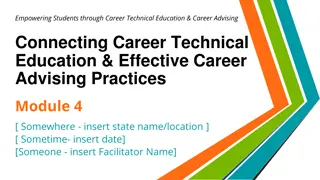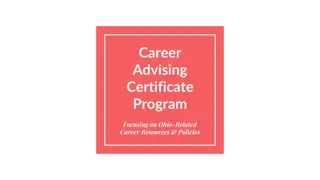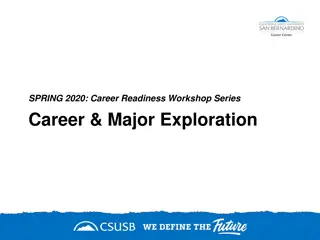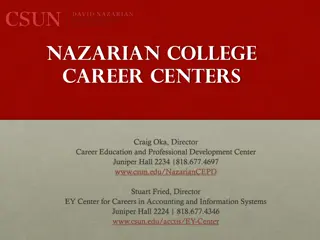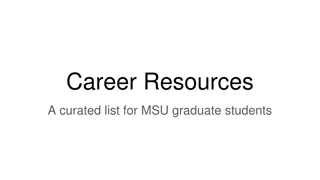Understanding Career Education Data Elements
Explore the essential data elements in career education such as Work-Based Learning, Industry-Recognized Credentials, Advanced Opportunities, Dual Enrollment, and Arts. Learn how these elements are utilized in reporting, data tracking, and program development. Discover the role of the CTE Data Team in recording and managing these elements for each course, and understand the process of Reporting and Data Element Definition in Career Education.
Download Presentation

Please find below an Image/Link to download the presentation.
The content on the website is provided AS IS for your information and personal use only. It may not be sold, licensed, or shared on other websites without obtaining consent from the author. Download presentation by click this link. If you encounter any issues during the download, it is possible that the publisher has removed the file from their server.
E N D
Presentation Transcript
Career Education and Career Education and Coursework Data Elements Coursework Data Elements (WBL, IRC, Adv Opps, DE, and Arts) (WBL, IRC, Adv Opps, DE, and Arts) Jessie Sloan CTE Data Consultant jessica.sloan@dpi.wi.gov March 2024
Agenda Agenda Reporting Data Element definitions Work-Based Learning (WBL) Industry-Recognized Credentials (IRC) Advanced Opportunities (Adv Opp) Dual Enrollment (DE) Arts and Creativity - subject areas
Reports Reports Career Education Data Elements are used for: School and District Report Cards Carl Perkins Accountability Reports and grant application Local review - viewable in WISEdash for Districts Arts and Creativity course data is used for: School and District Report Cards Wisconsin Arts Education Data Project Data points are recorded in the student information system (SIS) WBL, IRC, AP, IB, DE, the Arts are associated with courses Recorded in the course setup Flows to DPI through WISE, usually each night Learn from your SIS how to resync data if it needs to be changed
CTE Data Team CTE Data Team Create a Data Team to record these data elements for each course. Use the Roster Work Plan to write down each data element, for each course. Identify who creates/edits courses for your school. Editing courses is usually done when the course master is being made for scheduling each year (December-ish). Roster data is recorded at DPI on the December SNAPSHOT.
Reporting Reporting Roster Work Plan
Data Element Definition Data Element Definition Career Education Data Reporting - graphic Career Education Data Reporting Certified Career Education - courses or programs that have an outside organization guiding the curriculum, specific list Non-Certified Career Education - local control of curriculum, specific list Work-Based Learning - 6 criteria Industry Recognized Credentials - credentials that are earned by taking a course(s) Advanced Opportunities - Advanced Placement or International Baccalaureate courses Dual Enrollment - college/university courses taken while in high school
Certified vs Non Certified vs Non- -Certified Certified Non-Certified Career Education (outlined in green) are these specific 5 WBL types. 6 Criteria of WBL must be met to utilize these WBL programs. Wisconsin Guide to Implement Career-Based Learning Experiences Certified Career Education (outlined in red) consists of all IRC s and 3 types of WBL. Certified Career Education requires a final step in data reporting, Certificated Program Status Type. This is to be completed for each student enrolled in Certified Career Education programs, completed after the final grade is submitted. Courses can be identified as Certified for IRC or specific WBL type in the course setup. DPI highly encourages schools to create WBL courses to schedule students who are working toward the WBL portion.
Work Work- -Based Learning Based Learning 22.23 Work-Based Learning Entrepreneurial Student Business (Non-Certified) Internship/Local co-op (Non-Certified) School-based Enterprise (Non-Certified) Simulated Worksite Supervised (Non-Certified) Supervised Agricultural Experience (Non-Certified) State Co-op: Education Skills Standards (Certified) DPI Occupational DPI (Certified) Employability Skills (Certified) Youth Apprenticeship (Certified) 6 criteria of WBL (Non-Certified) 1. Involves sustained interactions, either paid or unpaid, with industry or community professionals. a. Sustained = minimum of 90 hours, can be rotated among employers and/or positions, the employer is engaged throughout the experience. Can take place in one semester, an entire year, the summer, or even a six-week period. b. Interactions must be more than just observing and include direct communication and involvement with industry or community professionals 2. Takes place in real workplace settings (as practicable) or simulated environments at an educational institution. 3. Fosters in-depth, firsthand engagement with the tasks required in a given career. 4. Aligns with a course (generally speaking should be a minimum of one semester). It is highly encouraged to provide credit for the work-based learning experience as well as credit for the school-based course. Certified already meets 6 criteria for WBL Certified Career Based Learning means that an outside organization creates the requirements that schools follow. Certificated Program Status Type is the final step to send this data. 5. Must include a training agreement between the student, employer/business, and school that defines the roles and responsibilities of the student, the employer, and the school. 6. Business and education partners work together to evaluate and supervise the experiences, which must be documented with training or learning plans and evaluation forms.
Industry Recognized Credential Industry Recognized Credential Industry Recognized Credentials are Certified Career Education Programs. IRC s are a credential that a student earns in a course or multiple courses. SIS vendors have directions on how to identify a course or add the Certified career education program individually to each student. This is an organization method. Just like Certified- WBL (previously presented) each student earning an IRC will need to have a Certificated Program Status Type added to their record at the conclusion of the course. CTE teachers should provide Data Entry with a list of students, earned certificated program status, and institution. Enter Certificated Program Status Type for each student, after final grading. Career Education: Info, Help and FAQs
WBL & IRC (1 of 2) WBL & IRC (1 of 2) Check WISEdata Portal>Exports>Certified/Non-Certified export Review columns J-Program Name and M-Certificated Program Status
WBL & IRC (2 of 2) WBL & IRC (2 of 2) Check WISEdash for Districts - this is the source of the DECEMBER SNAPSHOT! Snapshot>Career Education and Coursework>Outcome Count and Student Participation Count>Technical Skills Attainment Student Participation - Current View>Program Name, Program Type, Certificated Program Status, and Work Based Learning Program crosstab
Dual Enrollment Dual Enrollment All reporting of Dual Enrollment comes from the student information system and the course setup. Within the course setup, select Dual Enrollment and the type of institution within the course setup. The institutions options are listed in the yellow box. Assign a Roster/State/SCED code to the course that matches the curriculum. Ensure that each section of the course is reporting correctly for dual enrollment. Read the course description. Enroll students into the course. Courses should be created for Early College Credit Program, Start College Now, Transcripted, Articulated, and other college agreements. Submit a final grade for students in the course.
Advanced Courses & Arts Advanced Courses & Arts All reporting of Advanced Courses (AP and IB) and Arts comes from the student information system and the course setup. All of these course types require specific Roster/State/SCED codes for the data to be included properly on Report Cards. Assign a Roster/State/SCED code to the course that matches the curriculum. Use the specific year Courses download to select the specific AP, IB, or Arts Roster/State/SCED code. Sort the Courses download by column titled Course Program. Read the course description. Enroll students into the course. Submit a final grade for students in the course. Only courses with passing grades are included in Report Card counts.
AP/IB, DE, & Arts Courses (1 of 2) AP/IB, DE, & Arts Courses (1 of 2) Check WISEdata Portal>Exports>Roster: Course Offerings Sort by column P to check your AP/IB courses Sort by column W to check your Dual Enrollment courses Sort by AA to check your Arts Category courses
AP/IB, DE, & Arts Courses (2 of 2) AP/IB, DE, & Arts Courses (2 of 2) Check WISEdash for Districts - this is the source of the DECEMBER SNAPSHOT! Snapshot>Career Education and Coursework>Advanced Credit Opportunities Student Participation Count/Outcome Count - Current View>Adv Credit Type and Passing Status crosstabs *Pay attention to student details Passed. Two different dashboards: Student Participation Count - student counted one time Outcome Count - student may be counted more than once N/A-no grade was sent, no count for completion (report cards count completion) Topics>Coursework>any subtopic (course enrollment, course student enrollment by subgroup, arts participation by subgroup, postsecondary preparation by subgroup>find AP Course on the left and drag
Tips Tips Each student information system vendor has training! WISEdata Portal>Vendor Resources has a CTE Data webinar to explain each SIS vendor directions. Data must be reporting in WISEdash for Districts before December Snapshot. Reviewing data in WISEdash is the only way to ensure accuracy before a snapshot. Data changed in the SIS after the Snapshot will not be used for school report card or Perkins calculation for that reporting year.
More Tips More Tips Create a Data Team - multiple staff have their hands in the data. Who creates the coursemaster? Who schedules students into courses? How do you collect information from teachers that teach WBL, IRC s, AP, IB, DE, and Arts? How do you collect information about Dual Enrollment courses off campus utilizing Early College Credit Program or Start College Now? Identify who checks WISEdata Portal. Certified/Non-Certified Export CTE Participants CTE Concentrators Roster: Course Offerings Identify who checks WISEdash for Districts. Snapshot>Career Education and Courses Snapshot>Perkins Roster Work Plan - to organize your Career Ed data elements for each course
Resources Resources CTE Data Resources - CTE and Career Education Data WISE Guide Report Card Resources - Course & Program Data Guide Please reach out if you have questions! Jessica Sloan, CTE Data Consultant, jessica.sloan@dpi.wi.gov Mark Schwingle, Gifted and Talented Teaching and Learning Consultant, mark.schwingle@dpi.wi.gov Chris Gleason, Arts and Creativity Teaching and Learning Consultant, chris.gleason@dpi.wi.gov reportcardhelp@dpi.wi.gov for questions specific to School and District Report Cards DPI Help Ticket for questions about WISE data submission and troubleshooting
Questions? Questions? Thank you! Thank you! Please scan the QR code to provide us with your feedback!
